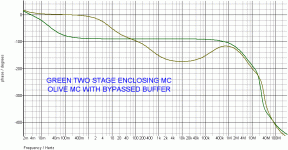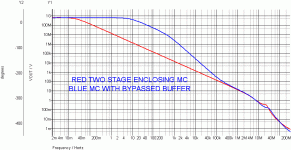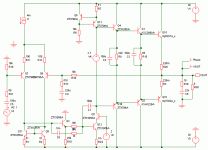Thanks Bob,
It would sure take out a lot of the bickering going on here if we can all agree on the important facts and not some semantic differences. Who wrote those rules anyway? Horn or waveguide, take your pick we all know they are used interchangeably in audio, as long as we can agree on that we can get to the real meat and potatoes.
It would sure take out a lot of the bickering going on here if we can all agree on the important facts and not some semantic differences. Who wrote those rules anyway? Horn or waveguide, take your pick we all know they are used interchangeably in audio, as long as we can agree on that we can get to the real meat and potatoes.
Two pages earlier i posted MichaelKawinuka s typical schematic but
with a compensation that bypass the VAS/TIS buffer at high frequencies.
It looks like the result is a quite different OL gain and phase response compared
to the usual miller compensation enclosing both the VAS/TIS and its buffer ,
actualy the curves are typical of a TPC but without the peak in frequency response
and thus with a phase shift that do not abruptly increase when transitionning to close to -180.
with a compensation that bypass the VAS/TIS buffer at high frequencies.
It looks like the result is a quite different OL gain and phase response compared
to the usual miller compensation enclosing both the VAS/TIS and its buffer ,
actualy the curves are typical of a TPC but without the peak in frequency response
and thus with a phase shift that do not abruptly increase when transitionning to close to -180.
Attachments
Thanks Bob,
It would sure take out a lot of the bickering going on here if we can all agree on the important facts and not some semantic differences. Who wrote those rules anyway? Horn or waveguide, take your pick we all know they are used interchangeably in audio, as long as we can agree on that we can get to the real meat and potatoes.
Back in the late 1980s, after working on the development of SONET (often now called STM) at Bellcore, I was involved in another since-forgotten technology called ATM - Asynchronous Transmission Mode. It was a fixed-length packet-based transmission system. I think a cell was 63 Bytes. BUT, low and behold, the international standards bodies got involved - and those from a certain influential European country managed to get the term "Octets" used in the standard instead of Bytes. Crazy.
Cheers,
Bob
Bob,
Wasn't that ATM transmission standard developed for telephone transmission? Bellcore was part of Bell Labs was it not? Since you had developed it you should have had the naming rights to go with all that development. I imagine that Phillips had something to do with the Octet naming?
Wasn't that ATM transmission standard developed for telephone transmission? Bellcore was part of Bell Labs was it not? Since you had developed it you should have had the naming rights to go with all that development. I imagine that Phillips had something to do with the Octet naming?
More precision, meaningfulness is nice - TMB, The Middle Bit ...I think we now have the most universal naming scheme for the VAS/TIS, I like
It would sure take out a lot of the bickering going on here if we can all agree on the important facts and not some semantic differences.
Hi Steven not wishing at all to bicker here but it seems funny (as in strange, odd) to me that arguing merely over what word is used is called 'semantics'. I reckon arguing over which particular pointer is appropriate to a meaning should be called 'syntactics' because in linguistics semantics is about meanings (which nobody's disagreeing on here that I can see) and syntax is about the pointers to those meanings.
Richard,
Blame that on my English teachers. You guys invented the language, we just butcher it as far as that goes! Do I need to keep a dictionary handy, perhaps that would help. But these days they are adding so much slang to the dictionary that I wonder if it is any use anymore?
Blame that on my English teachers. You guys invented the language, we just butcher it as far as that goes! Do I need to keep a dictionary handy, perhaps that would help. But these days they are adding so much slang to the dictionary that I wonder if it is any use anymore?
Its not just your teachers Steven, this is common usage. Why it differs from the usage of the word 'semantics' in the more technical area of linguistics is beyond me  No, you don't need to keep a dictionary handy on a forum such as this because if people get confused they can just ask for clarification.
No, you don't need to keep a dictionary handy on a forum such as this because if people get confused they can just ask for clarification.
All words in the dictionary started as 'slang',But these days they are adding so much slang to the dictionary that I wonder if it is any use anymore?
Bob,
Wasn't that ATM transmission standard developed for telephone transmission? Bellcore was part of Bell Labs was it not? Since you had developed it you should have had the naming rights to go with all that development. I imagine that Phillips had something to do with the Octet naming?
Yes, ATM was for telecommunications networks. SONET stands for Synchronous Optical NETwork. Bellcore was created at the 1984 Bell System Divestiture, when the Bell Operating Companies were split off from the AT&T mother ship. Bellcore was the research entity for the Bell Operating Companies. Bellcore was short for Bell Communications Research. It was the "Bell Labs" for the operating companies. I went from Bell Labs to Bellcore when Bellcore was created. The choice of the term "Octet" by the international standards body was largely at the behest of the French.
Cheers,
Bob
No swearing please Mr. Zan.Mike also recommends this.
Dun wuk.What about the proposal a few posts back to use an EF buffer on the VIS and return the Miller capacitor after the buffer rather than before?
One reason for the improvement brought by an emitter follower VAS/VIS/TIS stage enhancer (eg Blameless) is the the main device is now fed from a much lower Z than the output of the IPS/CM. Distortion due to it's evil modulated Cob is 'ignored'. But it means any HiZ feedback to that point (eg by plain Miller, TPC, TMC, 'pure Cherry' etc) is also 'ignored'.
You see this very clearly in the JE990 variants where the usual clamping diode reintroduces this evil which is the dominant THD mechanism in most applications.
kgrlee said:[lets ]... do some serious work...
JPV said:If R > 1/gm2 the positive zero becomes a negative zero and can be used to cancel a pole as it is done...
Du.uuh! I never considered doing both on Toni's amp. Need to see if I can persuade Toni to do more 'real life' tests.Dave Zan said:So, Mr Lee. The VIS emitter resistor bypass capacitor should be used with a Miller capacitor series resistor to force the zero into the LHP.
You need both to have sufficient free parameters.
There's a lot of sim work which I won't really have time to do properly before I ask but ...
.. unlike da sematic pedantic pseuds, I'm partial to 'real life' corroboration rather than [deleted : zillion pages of references that show I'm right and yus are all fools and your TLAs are wonky too]
Thanks to Guru JPV for suggesting a good line to investigate and Guru Zan for enlightening comments.
Hmmm! My .ASC of Toni's amp still doesn't show all the 'real life' effects he measures .. just hints
_______________
.. and get zillion pages of semantic pedantic drivel from da pseuds ..abraxalito said:No, you don't need to keep a dictionary handy on a forum such as this because if people get confused they can just ask for clarification.
Last edited:
Ha! That could work too. Or how about (C)ritical (T)ransfer (S)tage?More precision, meaningfulness is nice - TMB, The Middle Bit ...
After all, the VAS (as I keep calling it for now) is pretty much the most mission critical part of the 3 stages.
Hi Steven not wishing at all to bicker here but it seems funny (as in strange, odd) to me that arguing merely over what word is used is called 'semantics'. I reckon arguing over which particular pointer is appropriate to a meaning should be called 'syntactics' because in linguistics semantics is about meanings (which nobody's disagreeing on here that I can see) and syntax is about the pointers to those meanings.
"Semantics" is the most grossly abused word on this forum, paticularly by our American friends. "Semantics" is the study of language meaning, and doesn't mean what the Americans think it means at all.

It's a TIS and not a "VAS" old chap.
It is difficult to let understand colours to somebody watching a black and with TV . Try to understand the concept of point of view ( colour)
Quote Jan Didden,
"BTW Has anyone here started to read Doug Self's 6th edition? I just stumbled on a great section titled 'feedback intermodulation' (FID anyone?).
He provides, among other very worthwhile things, a solid technical reason why it is indeed a Good Thing to linearise your amp before applying nfb"
. Originally Posted by scott wurcer
Since it is well known for a long time that a non-linearity enclosed in a feedback loop creates new harmonics even from the simplest mathematical treatment, I don't see how this issue could be approached in a way that has nothing to do with previous results.
Didden,
Ah! One of the things Douglas found is that the shape of the initial increase of harmonic levels with increasing feedback, and the subsequent decrease when feedback continues to be increased, is very much dependent on the initial non-linearity of the forward path. (Howzzat for a short, succinct sentence?).
That may be somewhat intuitive of course but the upshot is that a small improvement in forward path linearity even to the detriment of the available feedback factor can greatly decrease this 'Feedback InterModulation'. At least that it how I read it.
But I'd like to hear how others look at this. It's somewhere around page 80 in his book.
Bob,
Having read your section on Negative Feedback what do you think of all this? Intuitively you would think that a more linear amplifier would require less feedback to linearize but it seems to go against the technical arguments about the loop speed for a feedback network and bandwidth if I am getting any of this correct.
"BTW Has anyone here started to read Doug Self's 6th edition? I just stumbled on a great section titled 'feedback intermodulation' (FID anyone?).
He provides, among other very worthwhile things, a solid technical reason why it is indeed a Good Thing to linearise your amp before applying nfb"
. Originally Posted by scott wurcer
Since it is well known for a long time that a non-linearity enclosed in a feedback loop creates new harmonics even from the simplest mathematical treatment, I don't see how this issue could be approached in a way that has nothing to do with previous results.
Didden,
Ah! One of the things Douglas found is that the shape of the initial increase of harmonic levels with increasing feedback, and the subsequent decrease when feedback continues to be increased, is very much dependent on the initial non-linearity of the forward path. (Howzzat for a short, succinct sentence?).
That may be somewhat intuitive of course but the upshot is that a small improvement in forward path linearity even to the detriment of the available feedback factor can greatly decrease this 'Feedback InterModulation'. At least that it how I read it.
But I'd like to hear how others look at this. It's somewhere around page 80 in his book.
Bob,
Having read your section on Negative Feedback what do you think of all this? Intuitively you would think that a more linear amplifier would require less feedback to linearize but it seems to go against the technical arguments about the loop speed for a feedback network and bandwidth if I am getting any of this correct.
It's a TIS and not a "VAS" old chap.
Not in my book, nor Self's
Remember, you will not normally find a TIS in a no-feedback amplifier.
Cheers,
Bob
Enough of this frivolity. 
If you take this feedback and linearisation to the extreme do you not end up with a no feedback amp? Is this feedback modulation a reasonable reason for going down this route? Or is distortion so low in a high feedback amp that you'd never notice?
If you take this feedback and linearisation to the extreme do you not end up with a no feedback amp? Is this feedback modulation a reasonable reason for going down this route? Or is distortion so low in a high feedback amp that you'd never notice?
- Home
- Amplifiers
- Solid State
- Bob Cordell's Power amplifier book


